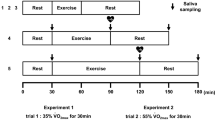Abstract
This study investigated the effect of daily relaxation on concentrations of serum immunoglobulins A, G, and M and secretion rates of salivary immunoglobulin A (S-IgA). Twenty-four volunteers were randomly assigned to practice a relaxation technique daily for 3 weeks and 16 to a waiting list control condition. Blood and saliva samples were collected before and after a supervised 20-min relaxation session at the beginning and end of the 3-week practice period. S-IgA secretion rate increased significantly (p<.001) after 20 min of relaxation. A longer-term practice effect also occurred in that the increase in secretion rate in “before to after” relaxation samples was higher (p=.014) in subjects who had practiced relaxation once a day for 3 weeks than in waiting list control subjects practicing for the first time. Serum IgA (p<.001), IgG (p<.001), and igM (p<.05) increased significantly over the 3-week practice period. Relaxation may be a self-regulating strategy affecting both humoral and cellular divisions of the immune system.
Similar content being viewed by others
References
American Psychiatric Association. (1968).Diagnostic and statistical manual of mental disorders (2nd ed.). Washington, DC: Author.
Barrett, J. T. (1980).Basic immunology and its medical applications. St. Louis, MO: Mosby.
Bartop, R., Lazarus, L., Luckhurst, E., Kiloh, L. G., & Penny, R. (1977). Depressed lymphocyte function after bereavement.Lancet, 1 834–836.
Benson, H. (1975).The relaxation response. New York: William Morrow.
Brandtzaeg, P., Fjellanger, I., & Gjeruldsen, S. (1979). Human secretory immunoglobulins: I. Salivary secretions from individuals with normal or low levels of serum immunoglobulins.Scandinavian Journal of Hematology, 12 1–15.
Derogatis, L. R., Lipman, R. S., Rickels, K., Uhlenhuth, E. H., & Covi, L. (1974). The Hopkins Symptom Checklist (HSCL): A self-report symptom inventory.Behavioral Science, 19 1–15.
Dorian, B., Garfinkel, P., Brown, G., Shore, A., Dafna, G., & Keystone, E. (1982). Aberrations in lymphocyte subpopulations and function during psychological stress.Clinical and Experimental Immunology, 50 132–138.
Genco, R. J., Evans, R. T., & Ellison, S. A. (1960). Dental research in microbiology with emphasis on periodontal disease.Journal of the American Dental Association, 78 1016–1036.
Green, R. G., & Green, M. L. (1987). Relaxation increases salivary immunoglobulin A.Psychological Reports, 61 623–629.
Jemmott, J. B., & Locke, S. C. (1984). Human susceptibility to infectious diseases.Psychological Bulletin, 95 78–100.
Kiecolt-Glaser, J. K., Garner, W., Speicher, C., Penn, G. M., Holliday, J., & Glaser, R. (1984). Psychosocial modifiers of immunocompetence in medical students.Psychosomatic Medicine, 46 7–14.
Kiecolt-Glaser, J. K., Glaser, R., Strain, E. C., Stout, J. C., Tarr, K. L., Holliday, J. E., & Speicher, C. E. (1986). Modulation of cellular immunity in medical students.Journal of Behavioral Medicine, 9 5–21.
Kiecolt-Glaser, J. K., Glaser, R., Williger, D., Stout, J., Messick, G., Sheppard, S., Ricker, D., Romisher, S. C., & Briner, W. (1985). Psychosocial enhancement of immunocompetence in a geriatric population.Health Psychology, 4 25–41.
Kiecolt-Glaser, J. K., Ricker, B. S., George, J., Messick, G., Speicher, C., Holliday, J., Garner, W., & Glaser, R., (1984). Urinary cortisol levels, cellular immunocompetency, and loneliness in psychiatric inpatients.Psychosomatic Medicine, 46 15–23.
Kubitz, K. A., Peavey, B. S., & Moore, B. S. (1986). The effects of daily hassles on humoral immunity: An interaction moderated by locus of control.Biofeedback and Self-Regulation, 11 115–123.
Lehner, T., Cardwell, J. E., & Clarry, E. D. (1967). Immunoglobulins in saliva and serum in dental caries.Lancet, 1 1294–1297.
Locke, S. E. (1982). Stress, adaptation and immunity: Studies in humans.General Hospital Psychiatry, 4 49–58.
Mancini, B., Carbonara, A., & Heremons, J. F. (1965). Immunochemical quantification of antigens by single radial immunodiffusion.Immunochemistry, 2 235–254.
McClelland, C., Floor, E., Davidson, R. J., & Sharon, C. (1980). Stressed power motivation, sympathetic activation, immune function and illness.Journal of Human Stress, 6(2), 11–19.
Roessler, R. L., Cate, T. R., & lester, J. W. (1979, March).Ego strength, life change and antibody titers. Paper presented at the annual meeting of the Psychomatic Society, Dallas, TX.
Russell, D., Peplau, L. A., & Cutrona, C. E. (1980). The revised UCLA Loneliness Scale: Concurrent and discriminant validity evidence.Journal of Personality and Social Psychology, 39 472–480.
Taylor, J. A. (1951). The relationship of anxiety to the conditioned eyelid response.Journal of Experimental Psychology, 41 81–92.
Tomasi, T. B. (1976).The immune system of secretions. Englewood Cliffs, NJ: Prentice-Hall.
Author information
Authors and Affiliations
Rights and permissions
About this article
Cite this article
Green, M.L., Green, R.G. & Santoro, W. Daily relaxation modifies serum and salivary immunoglobulins and psychophysiologic symptom severity. Biofeedback and Self-Regulation 13, 187–199 (1988). https://doi.org/10.1007/BF00999169
Issue Date:
DOI: https://doi.org/10.1007/BF00999169




